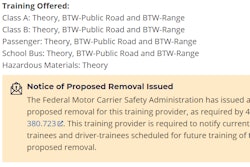
Spot market rates continued to drift further below contract rates as 2019 came to a close, said trucking economist Donald Broughton during a Dec. 17 webinar sponsored by PrePass.
When differences between spot and contract rates are brief or small, they usually have little impact on the contract market, said Broughton. But with the spread reaching 15% to 25% to close 2019, “the gap between the two is at record highs and is unsustainable,” he said.
Warren Hoemann, former deputy administrator at the Federal Motor Carrier Safety Administration, also spoke during the webinar, reviewing expected trucking regulatory developments for 2020.
One path toward more uniformity in spot and contract rates, said Broughton, is for traffic managers to shift more freight to the spot market. That “could come as a result of a rather severe increase in trucking company failures,” producing “declining capacity, which we haven’t seen yet,” Broughton said. Though Celadon’s failure was “very noteworthy,” given its size, the number of fleets going out of business in 2018 was a record low, and “2019 hasn’t been that high,” he said. Finally, resolving U.S. trade disputes could drive up spot rates, he said.
The bottom line is that spot pricing needs to improve in dry van, flatbed and reefer, or contract pricing needs to come down, said Broughton. The situation’s timing is bad for fleets looking to renegotiate a contract for 2020. The gap should be “significantly closed” in one direction or the other at some point in 2020, he said.

As for freight demand, Broughton offered little optimism. He cited declining trends in steel production, railroad tanker carloads, construction materials, housing starts and automotive sales. Office building and other commercial construction is showing some strength, but “single-family [housing] is dying.” This impacts other sectors tied to residential construction and the formation of new homes.
Among the expectations Hoemann cited for 2020:
- Compliance with the new drug and alcohol clearinghouse will have a short-term impact by reducing the driver pool. Long-term, drivers and potential drivers will learn, “Hey, this is an industry where you must be clean,” and there should be no dramatic changes in the driver pool.
- When a final rule is introduced for the hours of service revision, safety groups will resist. “Look for litigation,” Hoemann said.
- Proposed rulemaking on keeping non-preventable crashes out of the safety rating process should be introduced in 2020.
- Expect proposed rulemaking in 2020 regarding new drug testing methods – hair sampling and/or fluid sampling.









